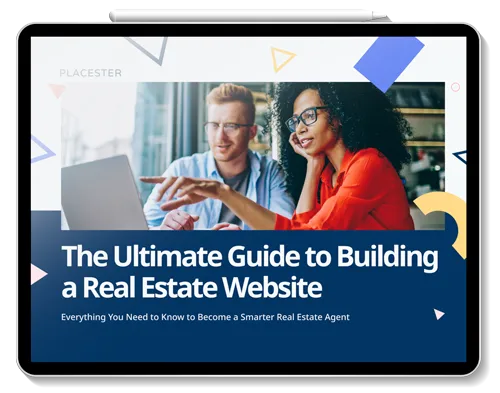Envision your real estate website. Does it make you cringe? Is it falling short? Are you secretly relieved that it doesn't attract much traffic? While we hope this isn't the case, the truth is that many businesses struggle due to poor websites, preventing them from getting noticed. Your real estate website can be a hidden treasure or a major letdown.
How often do you need to change your website?
When your site regularly converts a reasonable amount of traffic, and people stay on the page for some time (your bounce rate is low), you don’t need to do it too often. According to Business 2 Community, the average lifespan for a website is 1.5 to 2.5 years, which you can treat as a benchmark.
PRO TIP
Don’t fall into the trap of becoming somebody willing to test each novelty on their site. There are bound to be new improvements when you release your redesigned website. But it is all about functionality, and revamping should be treated as art for art’s sake.
5 Steps of a website redesign
We can break the whole process into 5 steps to make it easier.
- Analyze your current website.
Take note of what works and what doesn't work. You must know what is wrong with your existing website. Check:
- Usability. Think about your website layout and navigation.
- SEO and Content. Make a list of all recourses and ask yourself:
- Are any pages needing to be removed or added?
- Is the content easy to read and understand?
- Is it up-to-date and relevant?
Many tools can help you with content analysis, but you can start with Google Analytics and Google Search Console, which are free. You will see who comes to your website, how often and how long they stay, which blog posts are the most popular, and generally will be able to follow the user’s journey. SEO tools will help you detect glaring mistakes in your optimization: missing Meta or Alt descriptions for images, cannibalization, and irrelevant keywords.
- Conversion. Every website action prospects take should be tied to the desired conversion goal. That’s why you need to know:
- Who is your ideal customer? How did they learn about you?
- What CTAs would you want to include and where?
2. Research and analyze your competitors' websites
You may look closer at your rivals to understand what works and what doesn't in your industry.
- Look at their website design, color schemes, and typography. Are there any elements that stand out to you as particularly effective or ineffective?
- Take note of any features or functionality missing from your website that could benefit your business.
- Analyze your competitors' website content. Look at the language, tone, and messaging used on their website. Are they highlighting their unique selling points? Is their content informative and engaging? Take notes of any gaps or opportunities for improvement in your website content.
The ultimate 2024 guide to building a real estate website
Get your FREE copy now!
3. Define your new website goals
Set your future goals and determine what you want to achieve with your new website. Ask yourself if you want to increase website traffic and generate more leads, or maybe improve user experience and reduce bounce rates? Last, but not least: possibly you wish to showcase your real estate listings better? Having multiple goals for your website redesign is fine as long as you know how to measure the outcome and set their priority.
4. Renovation or demolition?
From a time-money perspective, taking on a website redesign can be challenging. In the short term, you may be fine just slapping on a new coat of paint, but sometimes it is not enough, and you will need a whole redesign strategy. It should include previously outlined goals and key performance indicators (KPIs). Think realistically about your budget and how fast you need the changes, and how major they should be.
5. Create a roadmap for your website redesign
Once you've made an informed decision to redesign, you need a strategic plan outlining the goals, milestones, and steps in developing or improving a website. Focus on the process while keeping these guidelines in mind:
- Keep it simple: A clean design isn't just visually appealing - it's also better to navigate than a cluttered one. Well, probably you stumbled on websites that are too much; there is no structure, and it’s impossible to understand what is where. So, think about creating an aesthetically pleasing website layout that is easy to navigate. Keep each section distinct and clear for understanding.
- Colors matter - don’t use those that clash with each other creating disharmony. Your colors should be the complementing background and not the main focus of your real estate website. The main focus should be the information you provide your clients with.
- Make sure it’s mobile responsive: More than half of web traffic comes from mobile devices these days; therefore, ensuring that your chosen theme caters to smaller screens is essential.
- Don’t forget about SEO: Everything from the structure of your website to the meta descriptions of your pages is necessary and should be considered while the site is being redesigned.
- Tailor your site to your specific audience and niche: If you want to showcase property listings, choose a theme with an effective search filter option for properties.
- Use high-quality images: In real estate, visual aesthetics significantly attract potential clients; hence, using high-resolution images is crucial.
- Prioritize quality content over fancy design. Focus on creating an information-rich site based on the search words users will most likely enter to find your pages. Content matters and Google will reward you if you create high-quality posts where keywords are naturally and logically woven into text. Revamping your site allows you to refresh content and develop a plan for ongoing engagement.
- Ensure your website is flexible and user-friendly. The most tiring process is searching for a dream house among many options. Take advantage of this issue and categorize listings on your website to make it easier. You can create pages for best deals, featured listings, hot properties, etc. It will help you to make your real estate website design stand out among competitors.
- Always showcase social proof and testimonials. What makes customers rely on you is the knowledge that they can trust you. Reviews and testimonials are the visual representation of this. Thus, you must include them to show customers you are successful and confident in providing the quality service you promised.
- Continuously measure progress against your goals. An immediate traffic increase is unlikely, but you should regularly monitor what happens on your site.
If you waded through the above points and still feel overwhelmed by the redesign task or don't have the hefty budget to hire a top-tier design team to handle everything for you, it doesn’t mean you must give up your redesign idea.
The reality is that unless you are really good at design and have massive amounts of extra time, you need professional help. Avoid going solo - not surprisingly, most homemade sites look, well, homemade. At best, they’re generic; at worst, they’re shoddy and dysfunctional. In today’s competitive market, consumers won’t tolerate generic, and they certainly won’t tolerate dysfunctional. They’ve gotten accustomed to great user experiences.
That’s why it is essential, and you should work with experienced designers, not amateurs, who fully understand the real estate industry. It doesn’t mean you can’t be involved in the creation process - you can and should. Ok, now you probably thinking: can it be done and on the budget? If this thought is causing anxiety, don't worry — our Placester team is here to provide guidance.
Real estate website redesign with Placester
How does it work?
1. Create your free account:
If you are not a Placester user, click a blue button to start a 30-day free trial, or book a DEMO to schedule a meeting with one of our experts and get a walkthrough our sites.
2. What happens next?
It depends on the plan you choose, but no matter your preference, it is very straightforward. All Placester sites start with a professionally crafted design, purpose-built for real estate by our UX/UI Design Team. They set a site’s style and functionality, giving you a great creative starting point. From there, you change layouts, copy, fonts, buttons, colors, modules & widgets to display your content as you see fit.
You can choose from three plans:
- Do It Yourself plan (DIY) - is dedicated to real estate professionals who want to create their IDX website by themselves using our 100% codeless, intuitive builder. DIY subscribers get access to over 30 fully customizable templates, researched and designed specifically for the real estate industry. Once you create your free account, you can choose one of the templates and start making your website. It is intuitive, but if you have any questions, don’t hesitate to contact our friendly support team or use the Knowledge Base to find the answers.
- Do It For Me plan (DIFM) - is dedicated to real estate professionals who want a new real estate website designed for them by Placester experts. It takes about 7 days to get your new website going. We migrate your old site (content, photos, name), but it is a great opportunity to work on updating information in all sections. After your website goes live, you can request content updates and design changes whenever you want.
- Do It For Me (DIFM) + Content - apart from a custom IDX website, Do It For Me + Content subscription offers unique blog and social media content written and published for you, Google Analytics setup, and paid advertising of 4 posts per month.
Our position is straightforward: in DIY (Do It Yourself), you shouldn’t need coding knowledge to change the look and feel of your site, add an agent, create an area page, modify copy, update images, load a video, or even optimize details like featured listings, office rosters, and SEO. DIFM (Do It For Me) is a personal approach to building client websites in both plans. We are using the same platform to build your website, but thanks to our knowledge and experience, we can redesign and adjust almost every site element to your needs without changing the website code.
Revamp or Miss out
In the highly competitive real estate industry, having a well-designed website with an exceptional user experience can make all the difference in lead generation. A dated website design can make your brand feel cheap or irrelevant. Selling properties relies heavily on visual elements, so your website needs to be appealing, work flawlessly, and be user-friendly.
In the real estate world, change is constant. If you don’t regularly work with a skilled designer to adapt to these changes, you’re putting yourself behind the competition. Remember, your website is never complete; it's constantly evolving. At Placester, we understand that, so you can make as many free website updates as you wish: from changing a few details or requesting new property pages to updating the layout to maintain an attractive and powerful platform that draws customers in.



.png)




